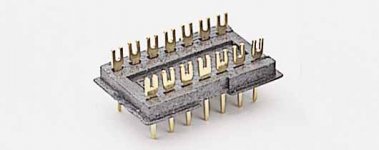AD8620
Hi Peranders,
I do have the AD8620 but I do not have a DIP adapter for it.
I received the AD826 from a friend .It is a dip version and I could pull out my existing IV from the DAC board and put in the 826. I wanted to know if anyone has compared these .
OK, I guess I will do this now and let you know what happens.
Cheers.
Hi Peranders,
I do have the AD8620 but I do not have a DIP adapter for it.
I received the AD826 from a friend .It is a dip version and I could pull out my existing IV from the DAC board and put in the 826. I wanted to know if anyone has compared these .
OK, I guess I will do this now and let you know what happens.
Cheers.
Re: AD8620
Start to solder 8 wires in the socket, then bend them and cut them. The last thing is to solder the SOIC chip.
The best socket here is a component adapter, socket for resistors, caps etc.
It's not very hard to attach a SOIC into a ordinary DIL socket.ashok said:Hi Peranders,
I do have the AD8620 but I do not have a DIP adapter for it.
Start to solder 8 wires in the socket, then bend them and cut them. The last thing is to solder the SOIC chip.
The best socket here is a component adapter, socket for resistors, caps etc.
Attachments
Listening test
I put this up in a new thread which is not right. So I am copying it here again and hop esomeone has some views of their own.
I have used the following as the buffer gain stage between a passive LC filter and the power amp. The DAC is a TDA1541.
1. OPA2134 gain stage with voltage series feedback.
2. AD826 used instead of the the OPA2134.
3. 6SL7 tube SRPP gain stage with voltage shunt feedback.
So I can use any one of these ( one at a time !).
The AD826 seems to be smoother than the OPA in the voice range. But deep bass and transients seem more punchy in the OPA2134. The difference is audible and I would like to know why. Only the chips are changed. So what's happening?
The tube stage beats the AD and the OPA by miles. The vocals are superb and transient attack and deep bass are incredible. The tube however would loose out in the distortion and signal to noise figures. Who cares , under normal ( loud) listening levels I can't hear those problems. So all the opamp IV users try out a simple tube stage. You might be in for a shock !
That's what's great about audio. At every turn there's something new. It will outlive me and that's what I want.
I will try out the 8620 as soon as I solder it to an adapter.
Cheers.
I put this up in a new thread which is not right. So I am copying it here again and hop esomeone has some views of their own.
I have used the following as the buffer gain stage between a passive LC filter and the power amp. The DAC is a TDA1541.
1. OPA2134 gain stage with voltage series feedback.
2. AD826 used instead of the the OPA2134.
3. 6SL7 tube SRPP gain stage with voltage shunt feedback.
So I can use any one of these ( one at a time !).
The AD826 seems to be smoother than the OPA in the voice range. But deep bass and transients seem more punchy in the OPA2134. The difference is audible and I would like to know why. Only the chips are changed. So what's happening?
The tube stage beats the AD and the OPA by miles. The vocals are superb and transient attack and deep bass are incredible. The tube however would loose out in the distortion and signal to noise figures. Who cares , under normal ( loud) listening levels I can't hear those problems. So all the opamp IV users try out a simple tube stage. You might be in for a shock !
That's what's great about audio. At every turn there's something new. It will outlive me and that's what I want.
I will try out the 8620 as soon as I solder it to an adapter.
Cheers.
- Status
- This old topic is closed. If you want to reopen this topic, contact a moderator using the "Report Post" button.
